Large heat loss of the room and cold air blowing from the ceiling, a consequence ...
|
|
A rather popular building element is considered a plastic window ... |
The time passed when the carpets were hung on the walls and covered the floors in the apartment. Carpet... |
How to cover wooden floor with varnish
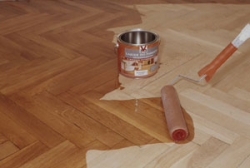
The wooden floor is most popular today, because the tree is a natural environmentally friendly material that does not contain allergens, has excellent thermal characteristics and has a unique ability to absorb excessive humidity from the room. To extend the life of your wooden floor or refresh its wiped surface, it is recommended to cover it with varnish. Let's find out what varnish to cover the wooden floor, and how to do it right.
Content:
- Choose a varnish for a wooden floor
- Prepare the surface for applying varnish
- Grind the wooden floor
- We apply the primer
- We apply varnish to the wooden floor
- Eliminate painting errors
- Work after applying varnish
1. Choose a varnish for a wooden floor
All varnishes for a wooden floor are divided by the type of solvent into water and organic. The latter are distinguished by toxicity and a pungent odor during drying. In the process of drying the water -soluble composition, exclusively water vapors with a small amount of substances that are present in the resins come out of it. On the other hand, most organic varnishes are highly resistant to mechanical stress of abrasion and impacts.

According to the type of resin used, varnishes for a wooden floor are divided as follows:
- Polyurethane varnishes, which are recognized by experts the best. And the most expensive are water -soluble polyurethane varnishes. Polyurethane resins give varnish coating strength and elasticity, maintaining a high level of environmental friendliness.
- Polyurethane-acrylic varnishes are inferior to polyurethane in price, elasticity and strength. The acrylic component is introduced into their composition so that the consumer can use inexpensive varnish in rooms where there are no intensive mechanical loads. At the same time, it is worth identifying the best spreading of such polyurethane-acrylic varnish in comparison with polyurethane.
- Acrylic varnishes are not particularly resistant to abrasion and blows, but they have moderate elasticity and good fluidity. The price of varnish for a wooden floor based on acrylic resin is democratic. In addition, these compounds are only water -soluble, so they have a high indicator of environmental friendliness.
- Uretan varnishes are of average abrasion resistance and are more affordable in terms of prices. According to other parameters (elasticity, water resistance and impact resistance), they are almost not inferior to polyurethane. They are also recommended for use in the conditions of frequent changes in temperature and moist regime. Uretan varnishes do not glue the ends of the parquences and do not contribute to the occurrence during compression and expansion of stress wood.
- Uretan-alkable varnishes are distinguished by all the properties of uretan varnishes, but thanks to alkyd resins they also demonstrate good indicators of abrasion and strength.
- Alkyd varnishes dry very quickly, are resistant to abrasion, have an average resistance to blows and slight elasticity.
- Epoxy varnishes are attributed to acid-adverse. They demonstrate high mechanical indicators, however, they distinguish toxins dangerous for humans during drying. Work with epoxy varnishing compositions should only be in a respirator with the presence of a special liner, which absorbs organic evaporation. The process of releasing toxins lasts about three days, so it is not recommended to be in the room without individual protection.
- Ural formaldehyde varnishes are another type of acid-adverse compounds. The presence of formaldehyde significantly reduces their environmental indicator. Such varnishes are the most dangerous, and free formaldehyde is divorced only after four days.
- Alcohol varnishes are made on an alcohol basis. In them, natural resins-sandaraki and shellacs are dissolved in them. Due to the high speed of the evaporation process of alcohol and the slight rate of dissolution of the resins, many layers of such varnish can be applied to the floor without destroying the previous ones. The coating of alcohol varnish is mechanically durable, with a great brilliance and good adhesion. But these coatings are characterized by low water resistance.
- Oil varnishes in their composition contain vegetable oils, resins of natural origin, as well as organic solvents. Oil varnishes are used for primary surfaces. After drying, the varnish on the wood leaves a solid film, the color of which, depending on the components, can be brown and light yellow.
Lucky differs in terms of shine: they are high -gloss, semi -glossy and glossy, matte and semi -dummy. The degree of glossy glossy varnish composition is 80-90%, so a wooden floor covered in such varnish shines like a mirror. Half -glossy and semi -water substances reflect less light from the surface.
When choosing a varnish for a wooden floor, it is also necessary to take into account the type of room in which work will be carried out:
- In the bathroom and in the kitchen, it is advisable to use compounds that are not afraid of moit of uretany, uretan-alkid and polyurethane varnishes for a wooden floor.
- For the living room, hall and wooden stairs, you need to buy substances that are especially resistant to abrasion. These include acid-adverse, organic and water-soluble varnishes based on polyurethane resins.
- For the children's room, water -soluble polyurethane varnishes and organized polyurethane compounds with a shortened exposure period, that is, releasing toxins only when applying and curing, are intended. Safe varnishes for children's premises contain the designation EN 71.3 on the package.
- In the country, it is advisable to use urethic-alkable and urethic varnishes, which are distinguished by high elasticity and retain their high properties even with significant fluctuations in the size of wood, which are caused by changes in temperature and moist regime.
- For areas with high operational load, urethic varnishes with an anti -slip effect are used.
2. Prepare the surface for applying varnish
If you have a new wooden floor, that is, it has never been covered with varnish before, then he does not need preliminary processing. But if your floor is made of soft and supple wood spruce and pine, then preliminary processing and grinding are mandatory even for new floors.
Preparatory measures are carried out in the following order:
- Take furniture and other items from the room.
- Inspect the surface of the floor for hooks, knots, sticking out nails and other sharp objects that are able to damage the emery in a grinding machine, and remove them.
- If some boards are very badly damaged, then it is better to replace them with new ones.
- To seal thin cracks in wood, you can use a special putty, which is intended for wooden coatings.
- Level the nail openings and holes from knots using a special mixture. For example, you can use homemade paste of carpentry glue and wood sawdust. Such funds are applied in circular motions using a special spatula and are left for drying for a certain time.
- Floor floors require a resin removal before applying the varnish, for this you should use ordinary gasoline.
- If you are faced with a layer of protective wax, then it will also have to be removed, because the wax is very contaminating the sandpaper. To avoid this, use a special tool or a white special.
3. Grind the wooden floor
Before painting a wooden floor, varnish should be polished well with a tape grinding machine, because various irregularities and splinters may remain on the surface. Also, mechanical grinding is required to remove the upper faded from the wood and give it a living color.
It is recommended to act like this:
- From dirt and old coatings, the floor is cleaned with a coarse -grained emery.
- Then replace the paper with a medium -grained one and thoroughly align the entire surface until the tree acquires its natural color.
- Finally walk through a grinding machine with fine -grained sandpaper.
- The corners and other inaccessible places for a grinding machine must be treated manually or using a special machine for corners and ends.
- After grinding, treat the surface of the wooden floor with an antiseptic. This procedure is not mandatory, but recommended to protect wood from insects, fungus and mold. The antiseptic dries in 24 hours.
- Also, the surface should be sprinkled, since microscopic waste remains on it after processing, which can spoil the appearance of the floor after coating with varnish and create the effect of grains of sand.
- To get rid of dust completely, you can use an ordinary wet rag. It is better to give preference to microfiber, since this fabric does not leave dust at all - neither on wet nor on a dry surface.
- You need to wash the floor with warm water, you can add a detergent. To get started, wet the small area of \u200b\u200bthe floor.
- If the tree has received a purple hue, it means that it contains a tannin. In this case, it is necessary to wash the surface without detergent. Also, do not use detergents in chestnut and oak parquet. After the wooden floor is washed, rinse the surface with clean water several times.
4. Apply the primer
Before covering the wooden floor with varnish, it is necessary to apply nitrolak to the surface of the wooden floor. Apply the primer with a brush, which has a width of 10 centimeters and a thickness of 1-5 centimeters along the structure of the tree. Make sure not to miss any areas.
When using a primer, it is necessary to take into account the following points:
- Wood, which contains tannins, especially oak, darkens in contact with polyurethane varnishes. To prevent this from happening, pre -oak parquet is opened with special cutting off soil.
- Special soil, but with other properties, is also required for pre -processing unstable beech wood. Before covering the beech floor with water -soluble varnish, it should be treated with soil, which does not glue the edges of the lamellas.
- Exotic wood should be treated with special soil before applying varnish, which neutralizes essential oils. Some breeds (IROKO and Lepacho) containing inhibitors - substances that slow down the action of the hardeners of varnish must be treated with cutting off soil designed specifically for heavy rocks.
5. We apply varnish to the wooden floor
The painting of a wooden floor is carried out with varnish in accordance with the following instructions:
- Carry out work on painting a wooden floor with varnish at air temperature in a room from 12 to 25 degrees above zero. Only at this temperature, the composition will dry well and will not lose its decorative and protective properties.
- Choosing between the tools with which you can paint the floor with a varnish - a roller, a pulverizer, a brush, it is better to give preference to the last solution, since the flooring procedure has some features. It is recommended to take a soft, wide (100 millimeters) brush, not shaggy and not decaying. Usually they are called varnish brushes.
- When applying varnish at hand, there should always be a towel so that separate boards re -wipe before coloring.
- Take into account how you will leave the room. If you do not think out this detail, subsequently many inconvenience arises, for example, when the only way to retreat will lie through a freshly painted floor. If you paint the staircase, then remember that the steps are recommended to varnish through one, since otherwise you cannot walk along it until the varnish dries.
- When applying varnish, remove the shoes, since it is clean bare feet on the surface that leave the least dust and traces.
- Before covering the wooden floor with varnish, first apply the composition to a small inconspicuous area with a thin layer to check the shade of the selected substance on your parquet. Let it dry completely and only then proceed directly to applying varnish to the surface.
- If you do not plan to use a primer, then it is recommended to apply the first layer with diluted varnish, which is able to penetrate deep into the tree. To do this, add a solvent to the solution in an amount of 1/3 to half of the varnish.
- Take a new brush (its dimensions should be the same as with priming) and apply the first layer of varnish. It is recommended to be applied from the window towards the door, along the wood fibers, carefully smearing each board. It is customary to make strokes in U-shaped movements so that the brush intersects with freshly condensed edges. Remember that there is no need to apply an excessively thick layer, as it will look quite inaccurate.
- If you decide to use a roller when covering a wooden floor with varnish, then the movements must be made cross -shaped. Movements across you will apply varnish, and with movements along - to level it. Then the roller rises to its width, and again the entire cycle is repeated.
- After application, let the varnish dry well. Each subsequent layer can be applied only after the previous one is completely dry. Different varnishes have its own drying time, which is indicated on the laca label. Therefore, you need to carefully read the instructions.
- In anticipation of drying the varnish, so that the brush does not become unusable, store it in a separate container, which contains a solvent. You can do it differently: take a rag, soaked it well in the solvent and wrap the brush first with a rag, and then a bag. If this is not done, the brush will dry out and even before the end of the work will become unusable.
- Immediately be prepared for the fact that after the first layer dries, some of the wood will rise a little. To make the surface perfectly smooth, it is recommended to grind each layer of varnish, except for the latter. This is done manually with fine -grained paper.
- After grinding the first layer of varnish, clean the surface of dust, thoroughly sprinkle and wash the floor. When the floor dries, you can apply a second layer of varnish. The breeds of wood of various firmness need to apply a different number of layers of varnishing composition. Soft rocks (spruce and pine) are best covered with three layers, others can be two. In rooms with increased cross -country ability, the third layer of varnishing composition should also be applied.
- After applying a sufficient number of layers, the floor should be left until completely dry, the drying time is indicated on the label. For a few more days after the varnish drying, try to move the furniture on the painted floor as little as possible.
- Even after applying the last layer of varnish, there will be a feeling that the floor is sticky. You can correct this problem by wiping freshly painted floors with soapy solution. For this purpose, you can also use dishes for washing liquid.
6. Eliminate painting errors
Often, when applying varnish to a wooden floor, there is a problem when the layer does not dry. There may be several explanations. The first thing that comes to mind is incorrectly selected (urethic or alkyd varnish will not dry on the tick), so the air temperature should be increased to 20 degrees in the room. You could also add a hardener to a two -component varnish for a wooden floor in an insufficient amount, so sake the applied layer. In the case of insufficient access of fresh air, ventilation should be increased into the room.
White influxes may appear on the surface of the wooden floor, which indicate that moisture was scundant on freshly lacquered. In this case, the influx should be treated with a solvent, and then carry out repeated varnishing. Naturally, before applying the room, warm and increase the temperature of the floor surface.
You can fight the detachments in a small area with a grinding. But if the swelling of the varnish layer is observed on the entire surface, then only a complete grinding of a caressing substance will save the situation.
The varnish of a wooden floor also implies such a problem as the formation of bubbles on its surface. In order to get rid of this, after applying the next layer it is necessary to draw the tip of the brush on the board, and you will get rid of such bubbles.
7. Work after applying varnish
After doing all the work on covering the wooden floor, it's time to thoroughly wash your hands. To remove the varnish from your hands, you can use the very solvent that you used to dilute the varnish before starting work. If a white spite was used, then you need to use it, if acetone, then rub your hands with acetone.
Remember that acetone of the skin of the hands corrodes more than white spirit. Having rubbed all the problem areas, it is enough to simply wash your hands using washing powder. Naturally, after that it is worth applying the cream.
So that you are not haunted by the unpleasant smell of varnish for a long period, the room should be well ventilated. To accelerate this process, you can use a gas burner that will help burn out the available solvent couples. It is enough just to burn a pair of solvent at one end of the room, which will significantly reduce their total amount.
Thus, it is useful to know how to paint a wooden floor with varnish. After applying varnish to the wooden floor, we will protect it from harmful external influences and preserve all the beauty of the tree. But remember that one or several times a year, if the varnish loses its splendor, you should use the composition to revive the old coating. This substance does not require preliminary grinding, but it gives the floor very well and hides cracks.


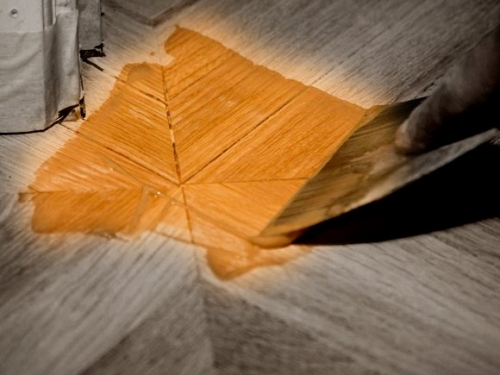
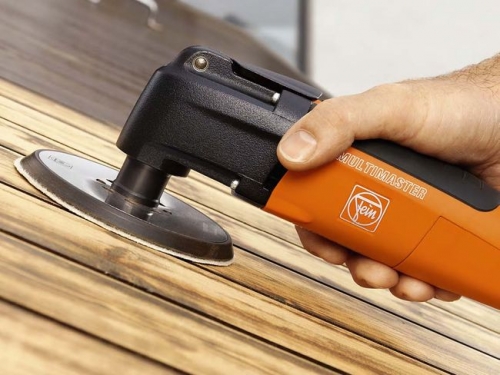
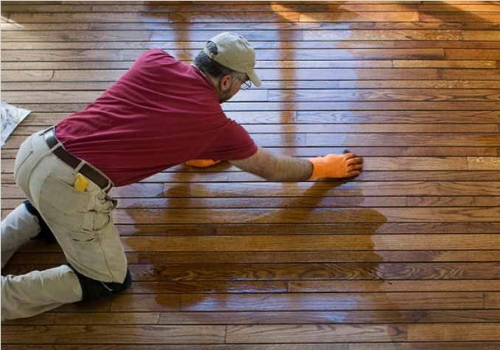
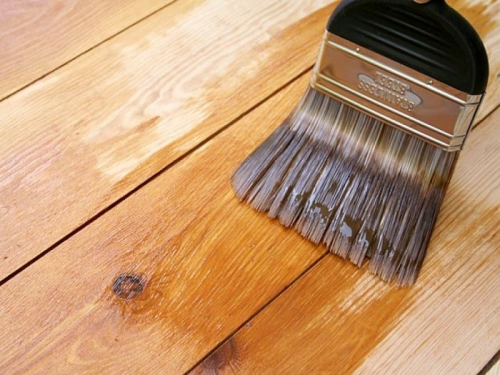
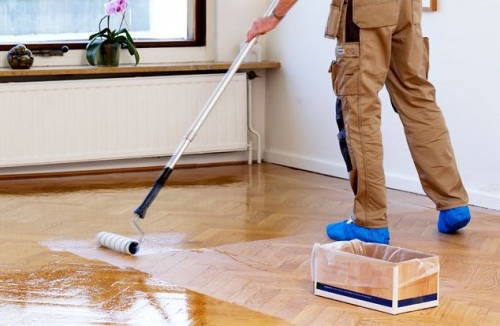
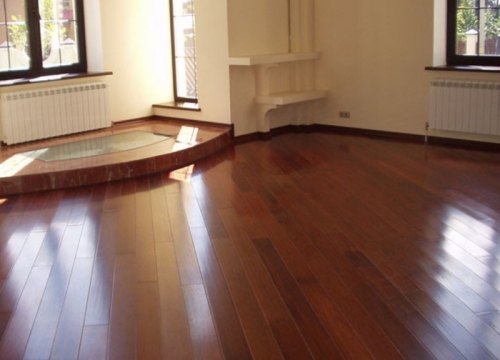
Good article. First
Good article. For the first time I ran into a tree, I did everything as it is written. Everything turned out great. thank you.
Good article
Good article
The article is excellent. Everything is clearly
The article is excellent. Everything is clearly, clear and brief. Thank you.